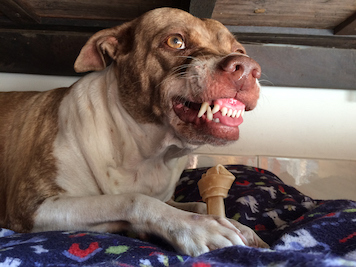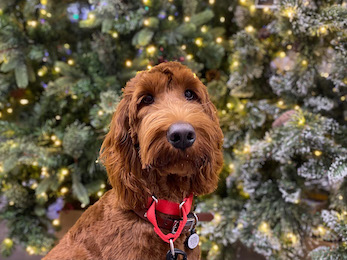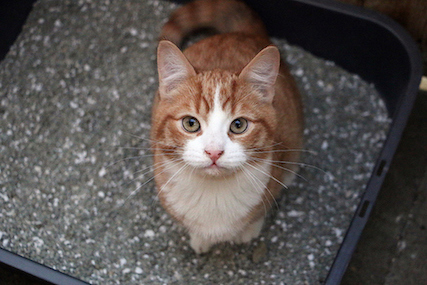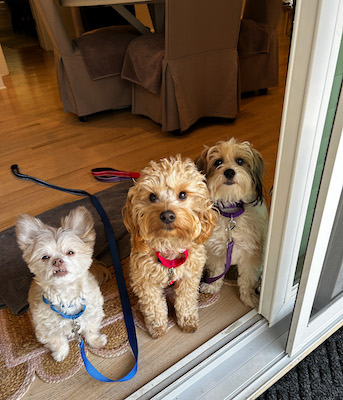
Resource guarding in dogs is a problem behavior that has caused my clients some of the most stress, confusion, and concern. You grab a sock from your dog’s mouth and are met with barred teeth, a low growl, and maybe even a snap. You don’t understand why your dog is behaving like this and wonder if guarding is merely in their nature or a serious red flag. Maybe you’ve seen your dog guard items from other dogs in the home, but it’s the first time they’ve directed the behavior at you. You start worrying about how your dog will interact with kids in the home and if it’s safe or not to get a new puppy.
Over the years, I’ve seen resource guarding present itself in many different ways: from the 12-year-old chihuahua that growls at you whenever they have an item but would never result in biting to the 3-year-old mixed breed who “randomly” attacked his owner over ice. When the behavior is not properly treated, it can lead to the bite of a beloved family member or a potentially life-threatening dog fight. Below is a culmination of my clinical experience as to why dogs resource guard. First, let’s cover the basics.
What is resource guarding?
Resource guarding is aggressive behavior when a dog has access to a valued resource such as food, a location, or a person, and a person or other animal approaches. The aggressive behavior is more likely to occur the more time the dog has with the item and if the person or other animal approaches from a farther distance. As you can imagine, these things vary from one moment to the next, often making the behavior feel random and unpredictable when in fact, it is not. The behavior is further intensified if the person or animal touches the dog. Dogs place value on items differently than people do so just because we don’t think dirty socks are valuable, doesn’t mean they can’t be a dog’s most beloved possession!
Signs of resource guarding include:
- Hunkering over an item
- Stiffening up over an item
- Running toward food and eating it when someone enters the room
- Hunkering over the item and staring out of the corner of their eye
When do dogs begin resource guarding?
The first signs of resource guarding can be seen in a puppy’s first zero to eight weeks of life. On average, puppy litter size varies from 1-12 puppies. In all litters, there is a degree of competition amongst puppies for precious resources such as mom’s milk or one shared bowl of food. Resource guarding can begin with this littermate competition. However, genetics and other environmental factors play a large role in the behavior’s development. What is even more interesting, is that for those puppies from very small litters with only 1-3 puppies, the behavior can be even worse, making resource guarding an even more complex, social behavior.
What causes resource guarding?
Resource guarding does not have one clear cause. Rather, it is a collection of several things to create this unfortunate behavior. What is clear are various risk factors associated with the development of resource guarding. These risk factors contribute to putting individual dogs and their pet parents in unfortunate circumstances.
Are certain dog breeds prone to resource guarding?
Does breed matter when it comes to resource guarding? Yes, certain breeds are at a greater risk for resource guarding; specifically, breeds bred to guard livestock or property, scent hounds, and lap dogs. Breeds that are bred to guard livestock or property are selected for certain guarding traits which can unintentionally generalize to resource guarding: Great Pyrenees, Anatolian Shepherd, Kuvasz, Rottweiler, Cane Corso, Komondor, Mastiff, Tibetan Mastiff, and the Napoleon Mastiff, to name a few! Scent hounds are also prone to resource guarding due to their strong sense of smell: Beagle, Bloodhound, and the Basset Hound. Lastly, certain breeds of lap dogs are prone to resource guarding given the personality traits selected to happily sit on laps: Chihuahua, Tibetan Spaniel, and the Japanese Chin.
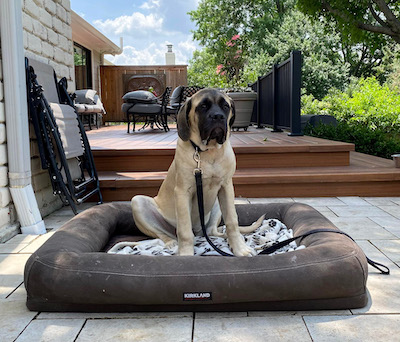
Preventative resource guarding exercises should be considered for all puppies, especially for the breeds listed above. And remember, just because the breed might be prone to resource guarding, does not mean an individual will resource guard. I consider breed to be a potential risk factor, but not a cause.
Conversely, some breeds show behaviors that could be misunderstood as resource guarding, but the true intent is completely different. For example, English labs tend to be chow hounds and eat their meals very quickly. Eating quickly can be a sign of resource guarding, but in this case, the lab simply loves food and devours it! Labs, Golden Retrievers, and others are prone to being quite oral, picking items up left and right. Sometimes, extreme interest in a toy is a sign of resource guarding, but just because these breeds pick items up does not mean they are showing early signs of resource guarding.
Early Environments
Puppies housed in less-than-desirable conditions or tight spaces like puppy mills are at a greater risk to resource guards. Conversely, homeless dogs with scarce resources but plenty of space are not at a greater risk for resource guarding once given proper nutrition. Interestingly, it seems to be a lack of space rather than a lack of food that contributes to this problem behavior.
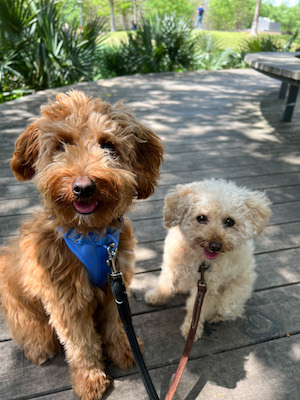
Training Techniques
Training techniques contribute to the development and worsening of resource guarding. If young puppies are harshly corrected for chewing, getting into the trash, or otherwise picking up items, they can begin to develop resource guarding. Even worse, if a puppy or dog is shocked in an attempt to eliminate chewing, counter surfing, getting into the trash, etc. resource guarding is likely to develop in the future.
Multiple Dogs in the Home
Sometimes pet parents get, what probably feels like, extraordinarily unlucky and have generations of dogs who engage in resource guarding. In these cases, a younger dog is brought into a home with an older dog who happens to resource guard. When these younger dogs and puppies are the victims of resource guarding, they begin developing it themselves. As they mature into adolescence and young adulthood, the behavior is more evident. Even worse, oftentimes, the dogs begin fighting one another, which is a challenging behavior to treat. Of course, some pet parents do not end up with generations of dogs who resource guard, but it can be a challenging and lifelong struggle.
Why does my dog continue to resource guard?
For some dogs, resource guarding develops or persists even without any obvious risk factors, or even after the risk factors have been alleviated. Unfortunately, once a dog has shown signs of resource guarding, without proper intervention, the behavior is likely to worsen. The problem behavior is maintained and strengthened innocently and somewhat unavoidably. If a dog has a resource and engages in aggression when someone comes nearby, the person backs off, and the dog keeps the item. In some cases, even for a few seconds. If the person does not back away, the behavior intensifies, producing a bite. A pet parent is in a lose-lose situation and is best to back away to prevent biting.
Is the behavior normal in dogs?
Although resource guarding is natural when animals in the wild have scarce resources, aggressive behavior in dogs and young puppies is not. Resource guarding was naturally and intentionally selected against during their domestication. Any severe, aggressive behavior involving resources is not typical, and it is recommended that pet parents pay attention to early signs of resource guarding. Sadly, the behavior worsens with age, and puppies do not grow out of resource guarding without proper intervention.
Can resource guarding be cured?
The good news is yes, resource guarding can be treated. Our trainers treat resource guarding with a combination of classical conditioning and positive reinforcement, including teaching specific obedience behaviors to help manage the dog’s behavior around resources. Dogs are taught to be less concerned about the resources and happily look forward to being approached by their loved ones. Just like with any behavioral training, there are a few factors that influence the likelihood of success.
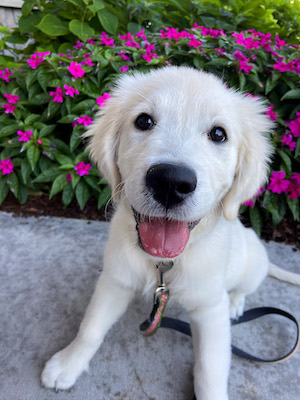
Age of the Puppy
If young puppies start resource guarding at a level that includes being unable to lift their head from food, snarling, and biting and wounding, the behavior is not only concerning but the likelihood of successful remediation is reduced. The behavior is likely genetic and extraordinarily abnormal. Oftentimes, in these rare cases, the behavior is not responsive even to intensive treatment.
Household Makeup
The makeup of the home is an important consideration when discussing treatment. Physical restrictions can make an oftentimes demanding treatment plan feel unattainable. Having older babies, toddlers, or young kids increases risk with resource guarding in many ways. Babies or toddlers might be at risk while innocently moving toward their furry friend and his resource. Those not-fully-developed brains can also be messy and careless with food items. Any parent has experienced this! Food is dropped on the floor, crumbs are left on the furniture, or food wrappers are left in bedroom or bathroom trash cans which can make it more challenging to manage and treat resource guarding.
When do I need to contact a professional?
A professional should be contacted for those pet parents who have a puppy, adolescent, or adult dog who is showing signs of resource guarding. I recommend contacting a local Certified Applied Animal Behaviorist as soon as possible. We offer in-home dog training programs in Austin, Dallas, Houston, and Kansas City. With 20 years of experience, our Certified Applied Animal Behaviorist and training team will create a treatment plan specifically designed to reduce and eliminate resource guarding.
In some cases, the behavior does not need to be treated. If the behavior is manageable and not dangerous, a pet parent may be able to safely leave the behavior untreated. In other cases, the behavior develops in a much older dog and no major life changes are on the horizon (e.g., adopting another dog, having a baby). Again, if the behavior can be managed safely or avoided, a pet parent might opt out of treating the behavior.
If you are unsure whether or not you need to contact a professional, feel free to contact us, and our team of experts can help determine the most appropriate course of action.
